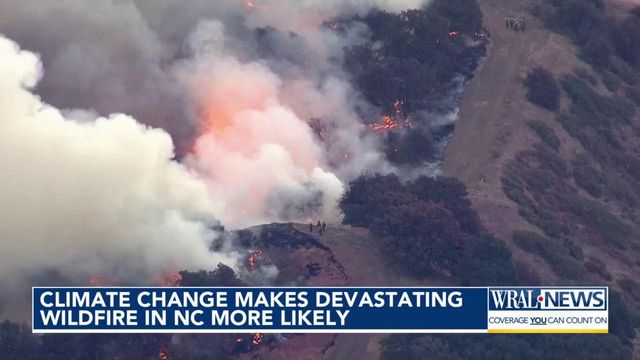Climate change could make devastating wildfires more likely in NC
Could North Carolina see quick-spreading wildfires like the recent ones in Maui, California and Canada?
North Carolina State University researcher Robert Scheller says risk is growing across the state and climate change is fueling the flames.
"The hotter and drier it is, the more wildfires there will be," Scheller said.
The size and frequency of wildfires across much of the Eastern U.S. has been increasing, according to a recent analysis of three decades of data.
Scheller says deadly wildfires such as the 2023 Maui fire that killed 101 people and the 2018 Camp fire in California that left 85 dead could happen in the Southeast with the right conditions.
"There's no reason we couldn't have another extreme drought in North Carolina," Scheller said. "If a fire starts and it just happens to burn into a populated area, you're going to see human mortality."
North Carolina has a spring and fall fire season, but data from the National Oceanic and Atmospheric Administration shows the greatest increase in fire weather days is happening in the spring months.
In March, as temperatures start to rise and days become longer, surface vegetation and fire fuels can get dried out more easily. Windy, low-humidity days are ideal for fires to start and spread.
Climate Central analyzed five decades of data from 476 weather stations across the U.S. to track trends in fire weather — the combination of high heat, low humidity, and strong winds. According to the data, North Carolina's central coast plain has ten more fire weather days than it did in 1973 and the southern coastal plain has eight. The Northern Piedmont region is now seeing 13 more fire weather days compared to a half-century ago, the largest increase across the eastern part of the country.
North Carolina is one of the top states with the greatest number of households in the wildland-urban interface (WUI), an area where buildings intermingle with undeveloped wildland vegetation.
"We're just seeing these sudden freak drought events happening around the world and it quickly overwhelms communities and resources, which is frightening," Scheller said.
World Weather Attribution, a research organization, determined Canada’s historic wildfire season that burned nearly 46 million acres last year was seven times more likely because of climate change.
The North Carolina Forest Service says it’s factoring climate change and land development into its mitigation and preparedness plans.
Residents can see wildfire risk across the southeast by using an interactive wildfire risk assessment map.
"When you get these extreme climate conditions in unusual places, they're not prepared and communities are really caught off guard," Scheller said.
About 85% of all wildfires in the U.S. are human-caused.
As North Carolina's fire season begins in March, officials want to remind residents to avoid leaving campfires unattended, limit burning debris, and be careful when discarding cigarettes.
The Biden Administration recently announced it will invest an additional $500 million into reducing wildfire danger, including a new effort focused on the wildland-urban interface.










